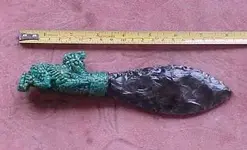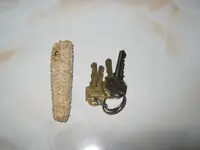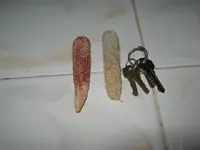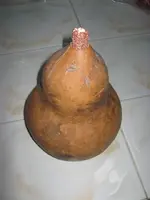I think I made it clear in my posting that I might be wrong when I said that cob was fresh. I even stated conditions which I had not experienced, such as dry country, in which a corn cob might remain new looking for a very long time. I have never seen that, and I have seen corn cobs in many different environments, in my younger days we burned them in the kitchen stove, even in house attics where squirrels carried them. And, they were dusty.
I have also seen old cobs in dry caves, secreted in niches, also almost certainly taken by wild animals of one kind or another, and they were covered with dust.
In my entire life old corn cobs either looked old and decomposed because they got wet, or they had dust on them, no exceptions, even in abandoned houses that we tight against the weather. I note you agreed you had no idea when that cob was dropped there. I must say I do.
Let me add there are in most places insects which will also do minor things to corn cobs. I have no idea what insects live there where you are.
The problem is any place that type of corn has enough water to grow is not going to be that bone dry -- unless there is a complex irrigation system, I suppose.
Also, I don't think you have explained why you think it is anything but fresh. Did you see it there a long time ago, and it is still there? If you say so, unlike you, I would have to take your word for it, instead of calling you a liar as you did to me for saying I lived on a corn farm for the first 22 years of my life.
Yet, I am not aware that you have stated that you lived on a farm and had personal knowledge of corn cobs as I did. Again, I will accept whatever you tell me. But, until you do, anyone who sees that picture and does not realize it is fresh would not seem to have been around corn cobs much.
I do resent being called a liar, which is what you did. And, due to that, I would not walk across my street to see it. Nor, probably, would it be a good idea.
The attached photo is a corn cob I just obtained from an uncle who lives at the corner of our property. Note the white color of the olote, or cob. Also, note the size.
That cob in your photo is not easy to scale, because there are no objects of known size in the picture. Except the little places where the kernels were. Corn kernels tend to fit a modest size range, except some popcorn. Based on the normal range of kernel size, that cob is of medium size.
Any corn farmer knows that as corn is inbred, the cobs and plants get smaller and smaller.
That red cob is a cross, based on its size.
I cannot say no primitive people ever knew to cross corn to get renewed vigor, but odds are they did what my uncle does. Each year he takes the largest ears, and uses the biggest kernels from each ear to seed the next time. This means that cob in my picture is extremely inbred.
They do sell hybrid seed corn here, but this corn, which may or may not, have come down through the ages, grows well in dry earth. They do get rain here, but sometimes not for weeks, so survival in dry earth is of primary importance. In other places where water from deep wells is available, they may well be able to use modern hybrids.
I don't know everything about corn that I'd like to know. For example, why are some cobs red and others white? Ancestry, of course, but does it tell us anything? On our farm, all the "field corn" was red, the sweet corn was white. And, except for guessing it is ancestry, I cannot tell you why.
If I am wrong on this, I'd sure like to know. I like to learn new things, and I do not like to be wrong. But, if I am wrong, I'd like to know, rather than calling those who disagree with me, liars, and you have given no data at all to show why that cob is not a fresh cob.




 . Thanks piegrande - it's not terribly often we get to hear legends from down your way about the Aztecs.
. Thanks piegrande - it's not terribly often we get to hear legends from down your way about the Aztecs.




